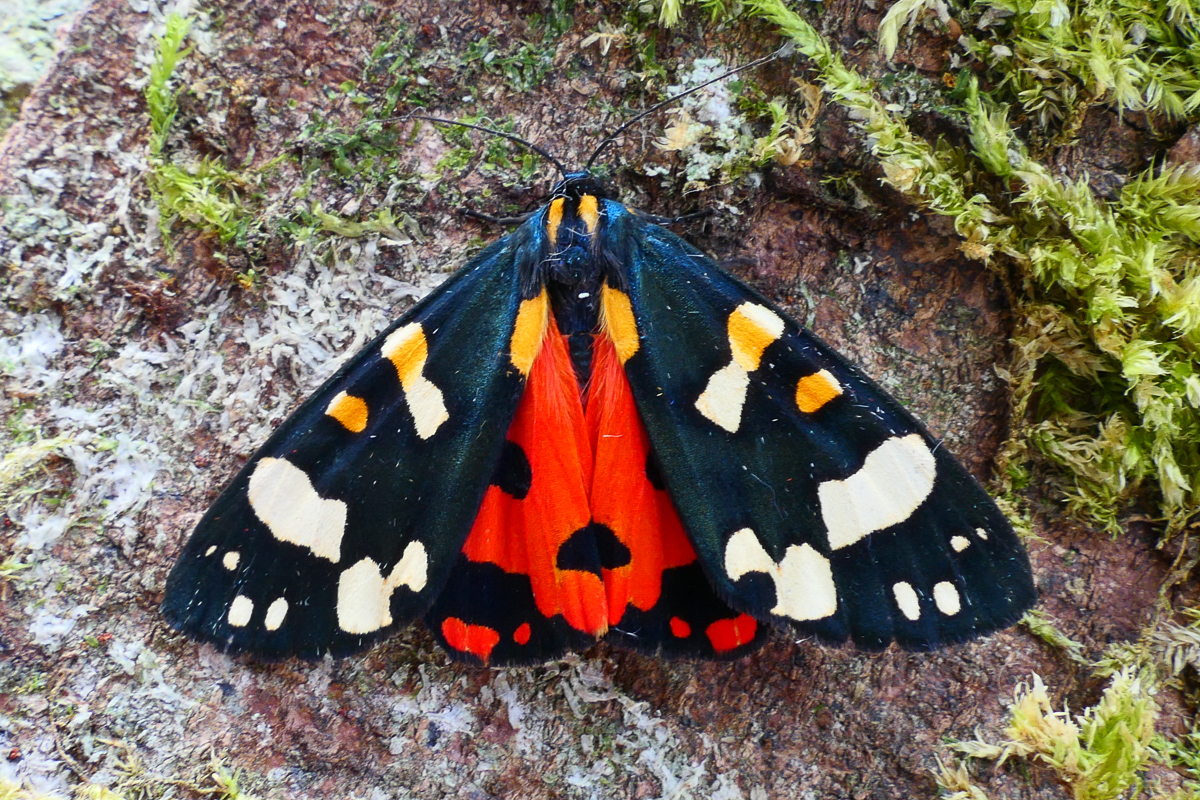
Photo © Andy Mitchell
The scarlet tiger moth (Callimorpha dominula, formerly Panaxia dominula) is a colorful moth belonging to the tiger moth subfamily, Arctiinae. The species was first described by Carl Linnaeus in his 1758 10th edition of Systema Naturae.
Subspecies within this species include:
This species is present in most of Europe and in the Near East (Turkey, South Caucasus and northern Iran). These moths prefer damp areas (wet meadows, river banks, fens and marshes), but they also can be found on rocky cliffs close to the sea.
Callimorpha dominula has a wingspan of 45-55 millimetres (1.8-2.2 in). Adults of this species are quite variable in color. The forewings usually have a metallic-green sheen on the blackish areas, with white and yellow or orange markings. Hindwings are red with three large and irregular black markings. These moths may also occur in rare color forms, one with yellow hindwings and body and one with extended black on hindwings. The thorax is black glossed with green and shows two longitudinal short yellow stripes. The abdomen is black. The scarlet tiger moth has developed mouthparts, that allow it to feed on nectar. The caterpillars can reach a length of about 40 millimetres (1.6 in). They are dark gray with yellow stripes and small white dots.
The imagines are active during the day in May and June. This species has a single generation. The caterpillars are polyphagous. They mainly feed on comfrey (Symphytum officinale), but also on a number of other plants (Urtica, Cynoglossum, Fragaria, Fraxinus, Geranium, Lamium, Lonicera, Myosotis, Populus, Prunus, Ranunculus, Rubus, Salix and Ulmus species).
The three morphs occurring in the population at the Cothill reserve in Oxfordshire, Britain, have been the subject of considerable genetic study (McNamara 1998), including research by E. B. Ford, Ronald Fisher and Denis Owen. Don McNamara (1998) describes how amateurs can rear this species.
Source: Wikipedia
The primary larval foodplants are birches (Betula spp.), Blackthorn (Prunus spinosa), Borage (Borago officinalis), Bramble (Rubus fruticosus), cherries (Prunus spp.), comfreys (Symphytum spp.), Common Evening-primrose (Oenothera biennis), Common Nettle (Urtica dioica), docks (Rumex spp.), Foxglove (Digitalis purpurea), geraniums (Pelargonium spp.), Green Alkanet (Pentaglottis sempervirens), Groundsel (Senecio vulgaris), Hemp-agrimony (Eupatorium cannabinum), Honeysuckle (Lonicera periclymenum), horsetails (Equisetum spp.), Hound's-tongue (Cynoglossum officinale), Meadowsweet (Filipendula ulmaria), Water Forget-me-not (Myosotis scorpioides) and Wych Elm (Ulmus glabra).